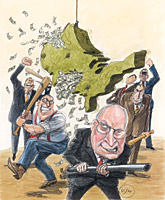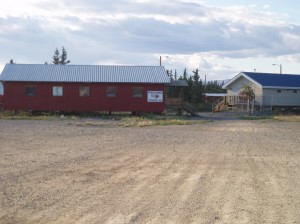
 Political ecology within the First World came from a gradual realization that the definition of the field did not only apply to exotic cultures abroad, but had resonance domestically. As first defined by Blaikie and Brookfield (1987), political ecology combines “the concerns of ecology and a broadly defined political economy. Together this encompasses the constantly shifting dialectic between society and land-based resources, and also within classes and groups within society itself” (17). Scholars returning from research in the Third World observed this shifting dialectic in their own countries, complete with struggles over power and access between sectors of society.
Political ecology within the First World came from a gradual realization that the definition of the field did not only apply to exotic cultures abroad, but had resonance domestically. As first defined by Blaikie and Brookfield (1987), political ecology combines “the concerns of ecology and a broadly defined political economy. Together this encompasses the constantly shifting dialectic between society and land-based resources, and also within classes and groups within society itself” (17). Scholars returning from research in the Third World observed this shifting dialectic in their own countries, complete with struggles over power and access between sectors of society.
The first call to the political ecology community to consider applying their principles to the First World came from Louise Fortmann (1996) in her article “Bonanza! The unasked questions: Domestic land tenure through international lenses.” Although she admitted there are vast differences between home and abroad, she identifies six lessons from the international land tenure debate that could have traction in the United States: property as social process, customary tenures, common property and community management of resources, gender, the complexity of tenancy relationships, and land concentration.The land tenure debate was also prominent on the political agenda in the rural western United States, as documented through a political ecological lens by James McCarthy and Peter Walker. McCarthy stated in his 2005 article, summarizing lessons from his work in the west, “surely one doubts that environmental politics and complex socioecological relationships are to be found everywhere”. His work in community forests in British Columbia directly spoke to Fortmann’s (1996) identification of common property as a unifying theme for a global political ecology. Previous to McCarthy’s description, community forests were assumed to be impossible under national capitalist and privatization pressures. The forests were supported through customary tenure creating a history and culture of commons resources in the area that encouraged community members to ignore national shifts in forestry management.

In his related examination of the Wise Use movement, he stated “Wise Use exhibited many features often said to be diagnostic of social movements centered on resource use and access in the global South: cultural identity, local knowledge as an alternative to expert science, reinventions of community and tradition, a resolute defense of the local, and action outside of and in opposition to state arenas were all central to its goals and tactics”. The abundance of cases in the rural West led McCarthy to look for other cases of rural alternative economies and he found many examples in fisheries and agriculture as well as forestry that had previously been assumed not to exist (McCarthy 2006).
Walker (2003) found many of the same processes at work in localities of the US as land tenure studies in the developing world, using that as evidence that the first/third world binary should be abandoned. However, he suggests that rescaling the political ecological approach is necessary to identify differences between the first and third world. He suggests returning to a regional political ecological analysis based on Blaikie and Brookfield’s (1987) approach. Noting that the local political ecology of the American West was embedded in larger social processes at the national and international level, he suggests a cross-scale analysis that has later become a standard approach of political ecology.
In the process, Walker redefines ‘local’, a term usually defined by time spent in a place and therefore largely indigenous. In his study areas, there were ‘locals’ defined instead by their knowledge of the local ecology and history even though they may have come from elsewhere as recent migrants and were embedded in a capitalist mode of production set by their nation. With this “looking up” from local to national and global scales, he identifies processes at the regional level, such as exurban migration, post-war labor restructuring, and communications advances, that transform global processes to regional distinction. These regional processes are better equipped to explain differences at a regional level despite similarities at the local and global levels than the First/Third world divide.
These early scholars advocated for breaking down the First World/Third World binary in order to recognize the Third World inside the First World and vice versa. Some scholars, such as Schroeder, went a step farther to say that academia’s aid in maintaining the First/Third Worlds binary helped reproduce capitalism and an expectation of the ‘rational actor’ in first world communities. Instead, abandoning the assumption of capitalist influence in a community might allow local processes to become apparent (Schroeder 2005). Therefore, ignoring the binary will allow scholars to recognize “the third world within”, produced by the same forces as the Third World (Schroeder, Martin et al. 2006). In addition, McCarthy (2006) and Robbins (2002) both point out that the First World has a tradition examining political ecology principles, but the discipline is named something else such as environmental justice. They advocate disciplinary collaboration, especially with reference to what questions are asked – the First World political ecology, as a newer subdiscipline, has many applicable questions that can be taken from Third World studies.

A possible substitution for the First/Third binary is the rural/urban. Replacing binaries does not address the argument that binaries limit analysis and reinforce social processes, but offers a different way of separating types of societies in the world. “The Third World within” the First world mostly refers to resource-dependent rural areas that do face many of the same processes as agrarian societies of the Third World. Conversely, cities in both First and Third world share processes unique to the urban environment. For example, scholars expanding political ecology to urban water systems note that processes of power and access are very apparent and management of water reinforces marginalization of certain people in the city whether in England (Bakker 2005) or Equador (Swyngedouw 2004).
After several studies of first world political ecology themes, a few scholars reflected on the shift in localities. Wainwright (2005) stated “simply transposing a research framework presupposes that spaces are distributed before our knowledge in an unproblematic way”. He argues that each region has a particular history and context that will require special attention in analysis. This argument fits with Walker’s call to return to the regional political ecology. Escobar (2004), writing from the perspective of a developing Third World, emphasizes the need for all countries to ‘look up’ to particular globalization processes and even treat some corporate behavior as a form of international governance. Escobar also echoes Walker (2003) in identifying a particular need to pay attention to cross-scale dynamics between the local and national or international.
Addition of First World studies has therefore moved political ecology from a local focus, adding scales of inquiry and also reinforcing the importance of historical and cultural context, often evident at a regional level. Each site of inquiry therefore requires a different framework of analysis based on this context. As a result, the debates of the applicability of political ecology to the first world have questioned the First/Third binary, arguing it limits complete analysis and potentially allows the overlooking of critical processes at work. Instead, there are a plurality of worlds that can be separated by region, each of which will have critical differences from the others. The debate has also questioned what it really means to be ‘political ecology’ as it has expanded an already diverse field, but McCarthy (2002) and Swyngedouw et al (2002) both help by providing a list of common elements or characteristics of political ecological studies for any context, for example:
“The major themes of political ecology include: access to and control over resources, marginality, integration of scales of analysis, the effects of integration into international markets, the centrality of livelihood issues, ambiguities in property rights and the importance of informal claims to resource use and access, the importance of local histories, meanings, culture, and ‘micropolitics’ in resource use; the disenfranchisement of legitimate local users and users; the effects of limited state capacity; and the imbrications of all these with colonial and postcolonial legacies and dynamics” (McCarthy 2002)
As political ecology studies continue to expand their breadth in new types of society and environment, new challenges are likely to arise and continually modify the “major themes”.
These studies make apparent the important differences in working in a regional context, most notably the consequences of blending important theoretical boundaries such as the first/third world divide and rural/urban dichotomy. If political ecology is to be applied to new contexts, researchers must engage in some self-reflection about underlying assumptions of the country they are in.
Best References (not all in the article):
Blaikie, P. and H. Brookfield (1987). Land degradation and society, Routledge Kegan & Paul.
Fortmann, L. (1996). Bonanza! The unasked questions: Domestic land tenure through international lenses Society & Natural Resources, 9 (5), 537-547 DOI: 10.1080/08941929609380992
McCarthy, J. (2006). Neoliberalism and the Politics of Alternatives: Community Forestry in British Columbia and the United States Annals of the Association of American Geographers, 96 (1), 84-104 DOI: 10.1111/j.1467-8306.2006.00500.x
McCarthy, J. (2006). Rural geography: alternative rural economies -the search for alterity in forests, fisheries, food, and fair trade Progress in Human Geography, 30 (6), 803-811 DOI: 10.1177/0309132506071530
Walker, P. (2003). Reconsidering ‘regional’ political ecologies: toward a political ecology of the rural American West Progress in Human Geography, 27 (1), 7-24 DOI: 10.1191/0309132503ph410oa